Wagner was not wholly satisfied with making characters who were merely people just like ourselves. (For Walter and Eva are people of our kind). But there are in the operas by Richard Wagner, gods and goddesses, giants and Rhine maidens, and Nibelungs.
Many of them have strange names. These names are easy to remember because they are strange: Wotan and Donner are gods. Freia and Erda are goddesses. Fafner is a giant. Flosshilde is a Rhine daughter. Mime and Alberich are Nibelungs.
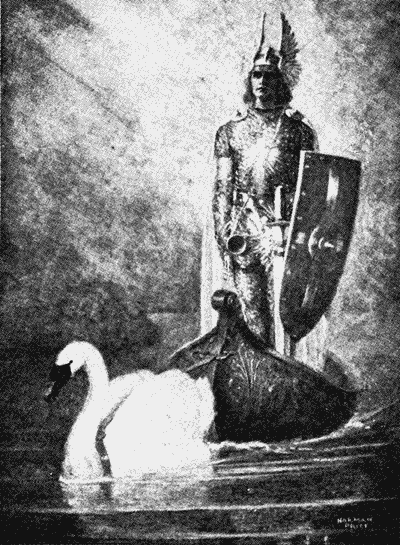
LOHENGRIN
Oh, they are wonderful company these gods and goddesses, and others of the company who tell their story and adventure in the operas of the Nibelungen Ring. Here is Siegfried forging his Magic Sword Nothung.

SIEGFRIED
Now, as we have said, when we learn of so great a man we always wonder what sort of a boy he was. Well, when this boy was nine years old he went to a classical school. One of his teachers at least must have been very fond of him, and he must have been fond of his teacher, for when Richard Wagner was only thirteen years old he translated from Greek into German twelve books of the Odyssey for this teacher.
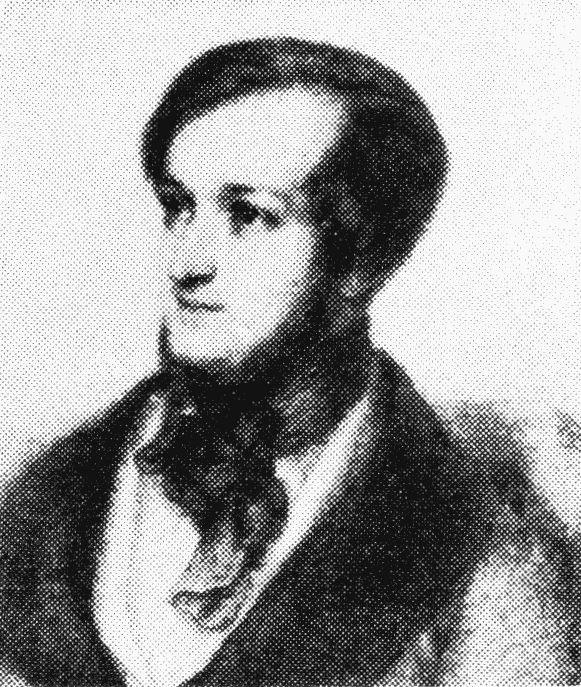
WAGNER AS A BOY
"I intend to become a poet," he used to say. He read Romeo and Juliet in English. Then he wrote a play in which were Hamlet and King Lear. And there were forty-two other characters. All of these died or were killed in the fourth act and were brought back as ghosts in the fifth! He played the piano, too, and seems to have been quite as busy a boy as he was a man.
Of one composer's music he was very fond. This composer lived nearby and passed the Wagner house almost every day. Richard always ran to the window to watch him coming. This musician was the composer of Der Freischütz and ofOberon. Can you guess his name?
This composer's father was also a musician as well as a military man.
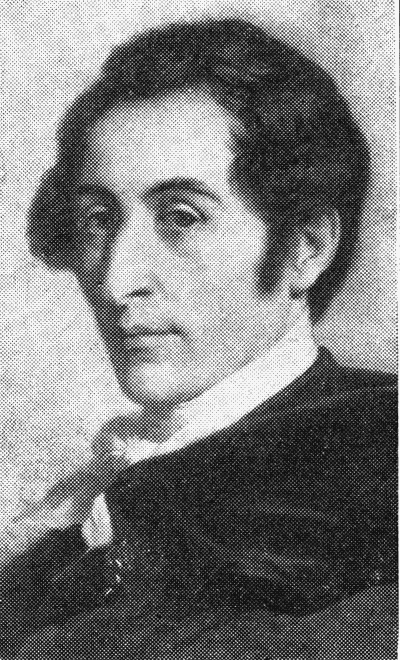
WEBER
Children will be glad to know that Wagner was very fond of animals. Here he is with a picture of one of his dogs. His favorite dogs are buried in the garden of his home at Bayreuth, where Wagner is also buried.
Wagner called his home at Bayreuth "Wahnfried," which really means "Fancy Free."
It is beautifully located in the heart of the old town.
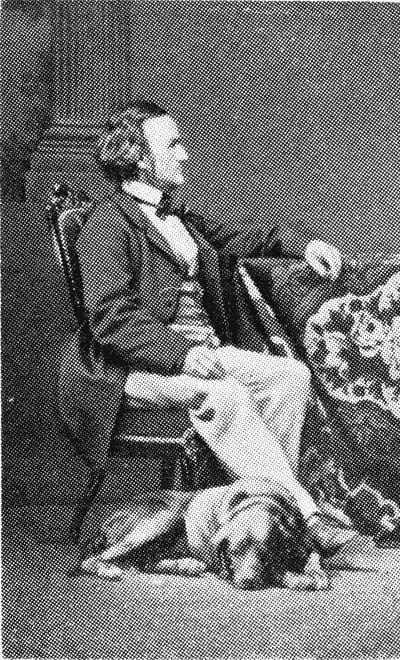
No. 16 WAGNER AND HIS DOG
Later on the boy read about the contest of Die Meistersinger. He was then sixteen. And he read, too, a poem called Tannhäuser. He kept these stories in mind until he became a man and then he wrote an opera about each.
Thus we see that we carry childhood thoughts into manhood.
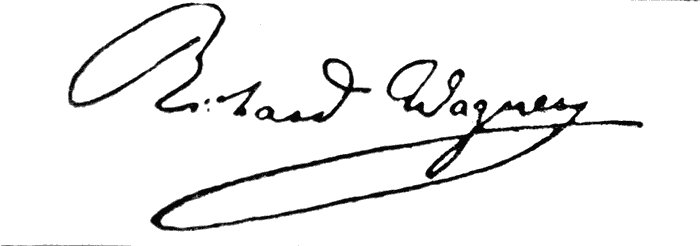
No. 17
Here is a list of the operas by Richard Wagner, with their names pronounced:—
The Fairies (1833).
Das Liebesverbot (1836) leebes-fehr-bote.
Rienzi (1842) ree-ent'-see.
The Flying Dutchman (1842).
Tannhäuser (1845) tan'-hoy-ser.
Lohengrin (1847) lo'-en-green.
Das Rheingold (1869) rhine-gold.
Die Walküre (1870) dee val-kee-reh.
Siegfried (1869) seeg'-freed.
Tristan and Isolde (1865) e-sol'-deh.
Die Meistersinger (1867).
Die Götterdämmerung (1876) dee getter-day-meh-roongk.
Parsifal (1882) par'-se-fal.
Wagner also wrote symphonies and a few works for chorus and orchestra, but he is so much greater as a composer of music dramas that he is known mostly for his works for the stage.
This concludes our tale. Now, on to the wonderful music of Richard Wagner. Please join me next week for 2 weeks of the best in videos of live Wagner performances.
Many of them have strange names. These names are easy to remember because they are strange: Wotan and Donner are gods. Freia and Erda are goddesses. Fafner is a giant. Flosshilde is a Rhine daughter. Mime and Alberich are Nibelungs.

LOHENGRIN
Oh, they are wonderful company these gods and goddesses, and others of the company who tell their story and adventure in the operas of the Nibelungen Ring. Here is Siegfried forging his Magic Sword Nothung.

SIEGFRIED
Now, as we have said, when we learn of so great a man we always wonder what sort of a boy he was. Well, when this boy was nine years old he went to a classical school. One of his teachers at least must have been very fond of him, and he must have been fond of his teacher, for when Richard Wagner was only thirteen years old he translated from Greek into German twelve books of the Odyssey for this teacher.

WAGNER AS A BOY
"I intend to become a poet," he used to say. He read Romeo and Juliet in English. Then he wrote a play in which were Hamlet and King Lear. And there were forty-two other characters. All of these died or were killed in the fourth act and were brought back as ghosts in the fifth! He played the piano, too, and seems to have been quite as busy a boy as he was a man.
Of one composer's music he was very fond. This composer lived nearby and passed the Wagner house almost every day. Richard always ran to the window to watch him coming. This musician was the composer of Der Freischütz and ofOberon. Can you guess his name?
This composer's father was also a musician as well as a military man.

WEBER
Children will be glad to know that Wagner was very fond of animals. Here he is with a picture of one of his dogs. His favorite dogs are buried in the garden of his home at Bayreuth, where Wagner is also buried.
Wagner called his home at Bayreuth "Wahnfried," which really means "Fancy Free."
It is beautifully located in the heart of the old town.

No. 16 WAGNER AND HIS DOG
Later on the boy read about the contest of Die Meistersinger. He was then sixteen. And he read, too, a poem called Tannhäuser. He kept these stories in mind until he became a man and then he wrote an opera about each.
Thus we see that we carry childhood thoughts into manhood.

No. 17
Here is a list of the operas by Richard Wagner, with their names pronounced:—
The Fairies (1833).
Das Liebesverbot (1836) leebes-fehr-bote.
Rienzi (1842) ree-ent'-see.
The Flying Dutchman (1842).
Tannhäuser (1845) tan'-hoy-ser.
Lohengrin (1847) lo'-en-green.
Das Rheingold (1869) rhine-gold.
Die Walküre (1870) dee val-kee-reh.
Siegfried (1869) seeg'-freed.
Tristan and Isolde (1865) e-sol'-deh.
Die Meistersinger (1867).
Die Götterdämmerung (1876) dee getter-day-meh-roongk.
Parsifal (1882) par'-se-fal.
Wagner also wrote symphonies and a few works for chorus and orchestra, but he is so much greater as a composer of music dramas that he is known mostly for his works for the stage.
This concludes our tale. Now, on to the wonderful music of Richard Wagner. Please join me next week for 2 weeks of the best in videos of live Wagner performances.
No comments:
Post a Comment